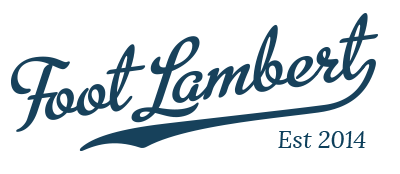Mamiya C330F – Review
The Mamiya C330F is a TLR style medium format camera, produced in the 1970s. The twin lens configuration, mounted on rails with a bellows, allows for macro shots without any additional lenses or equipment. I bought my Mamiya C330F from Superbuy in my home town of Wakefield during the summer, and it has soon become on of my favorate cameras.
High quality, low price
After seeing the results of 6×6 photography in Dennis Boussard’s Le Mans book, I too wanted to try a medium format 6×6 camera of real quality. Unfortunately, a Rolleiflex was simply too expensive, costing over ten times what I paid for my Mamiya (£140), and I felt that this camera would offer a similar image quality. Having seen my sister’s C330F, I felt it would be the ideal camera to explore 6×6, and would be a substantial upgrade from the Rolleicord 1A.
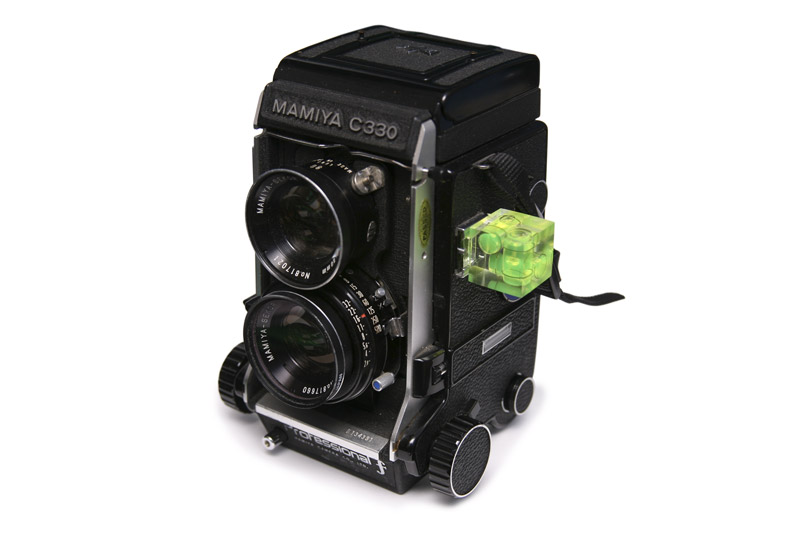
The C330F pictured with a spirit level in the cold shoe. This camera weighs nearly 2kg, but is worth it’s weight in gold in terms of image quality.
Out in the wild (Barnsley)
My first test of the camera was at the Genius Division 2nd year birthday party in Barnsley. I used a single roll of Delta 400, to test out the camera. As this camera doesn’t have a built in light metre, I used a hand held Sekonic L-308 meter to find the right aperture and shutter speeds.
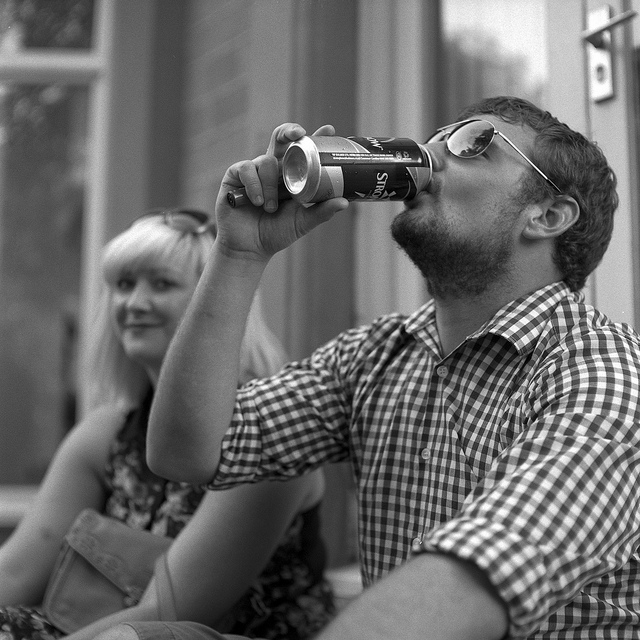
Super sharp results, and excellent blurring from the 80mm Sekor 2.8 lens. The tonal variation from the Delta 400 in DD-X also works really well in this format.
I was really impressed with the quality of the photographs that came out. The lens is a little soft at f/2.8, but when stepped down to f/4, the lens becomes super sharp. It really gets the best out of the film, while the satisfying winding of the crank adds to the experience.
An inevitable cat picture, in Howarth
I took the camera on a day trip to the Keighley & Worth Valley Railways during the summer, and after a trip on a steam train ended up in Howarth. Here, a big fluffy cat the lives at the fish & chip shop posed suitably for a photograph on the Mamiya.
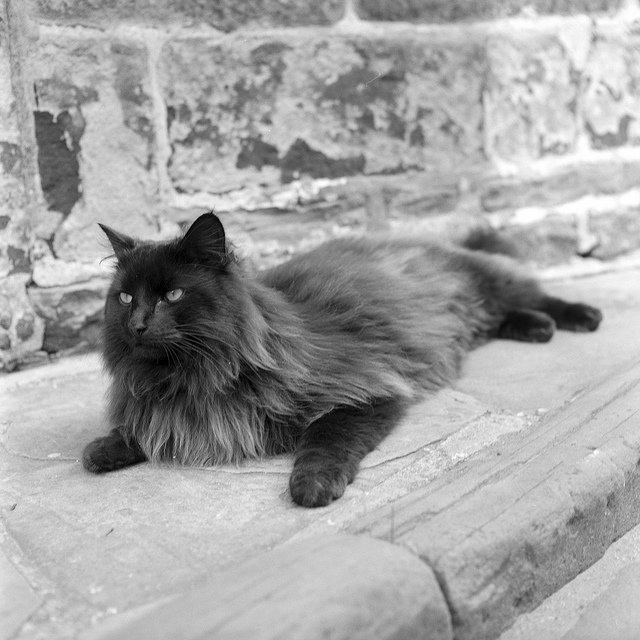
This cat gave the Mamiya an opportunity to show off both it’s sharpness, tonal range and excellent detail. Using the depth of field with this camera really is a joy.
The large weight and bulk of the C330F can be wearing and difficult at times, but if you take the camera with you you’ll be rewarded with excellent photographs. As with all fully manual film cameras, the C330F isn’t massively quick to operate, and requires patience, concentration and a lot of thought to frame, setup and take a shot. Again, the camera will reward those who are prepared to do this.
In colour, and with motorsport
At the Cadwell rounds of the BARC championship, I took the Mamiya along to photograph around the paddock. I chose Kodak Ektar 100 as the film I’d use, due mainly to the beautiful bright conditions.
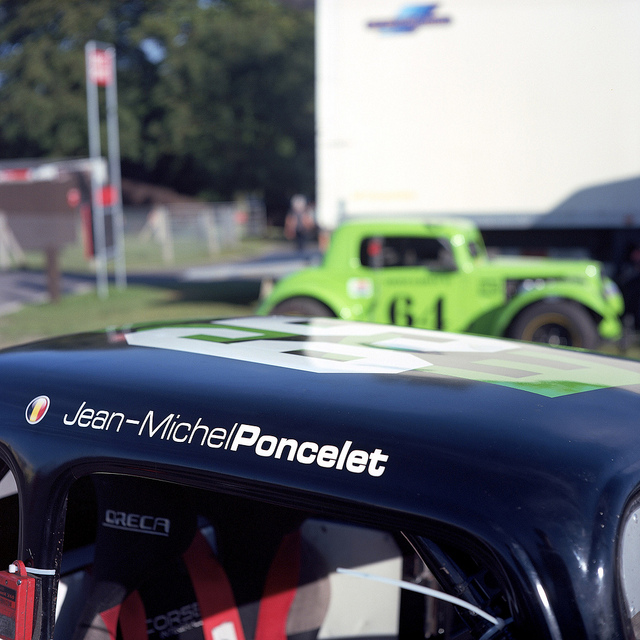
Photographing in the paddock was really challenging – framing with the 6×6 format is tough to do. However, the C330F produced brilliant colours with Kodak Ektar 100
My photographs came back with great image quality, but I found creating interesting compositions a real challenge. Due to the lack of orientation with 6×6, straight images are usually the kind of pictures that work best in this format. I added a 3 way spirit level I bought off ebay into the cold shoe to help me line up level shots. I wasn’t disappointed with the camera with my Cadwell shots, but disappointed with myself that I couldn’t get better compositions.
Better results with black and white at Cadwell
I did however have better results with black and white. Spotting interesting details and using the prime nature of 80mm to photograph them produced some great results. Depth of field with this lens is the key to unlocking great medium format images.
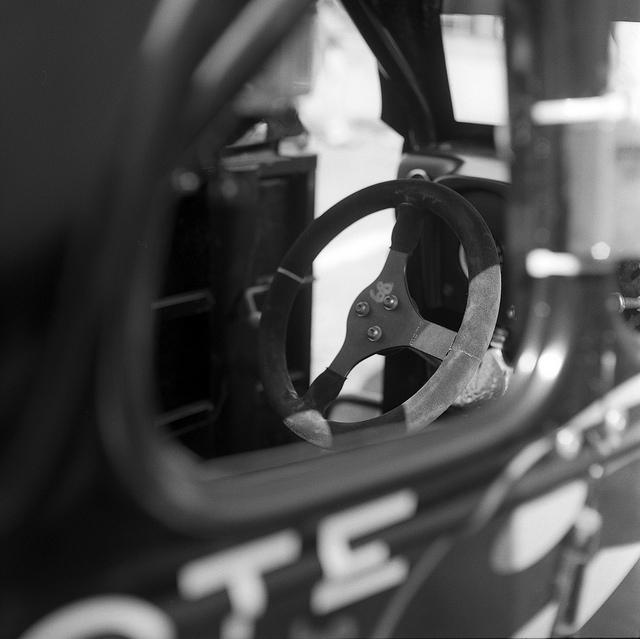
A frame within a frame style image of a Legends car steering wheel. The lens and format manages to pick up the Alcantara on the steering wheel
Loading film into the Mamiya C330F is very easy – simply load an empty reel into the top of holder, place the film in the bottom holder. Film can then be wound through the empty reel by rotation the crank. Once the large arrows point into the red dot in the back of the camera, the back can be closed and the film wound on. The crank system automatically locks after each wind, but there is an option for multiple exposures too.
Leading lines and composition
I took the Mamiya down to the Hepworth gallery in Wakefield, again loaded with Ektar 100. Framing compositions of this stunning building is easy, as it looks great from every angle.
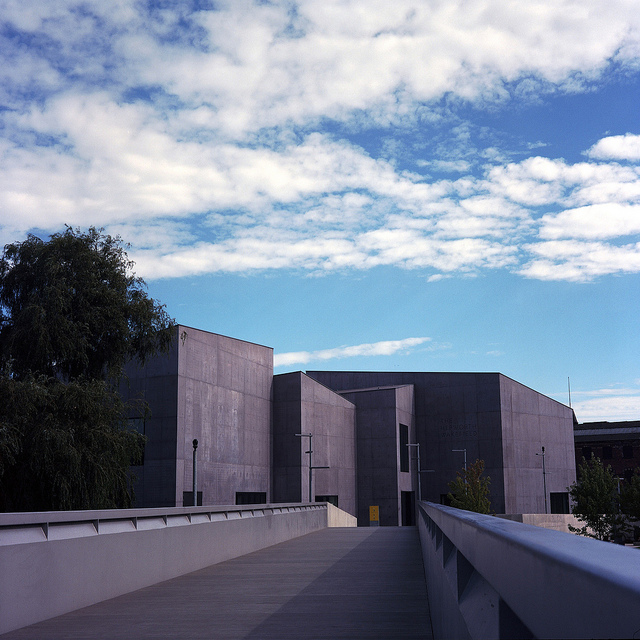
The Hepworth gallery against a beautiful blue sky. The shadows on the building really bring out the form and structure.
The square format is useful for architecture, as using the lines to lead the eye into the centre of the frame can produce good compositions.
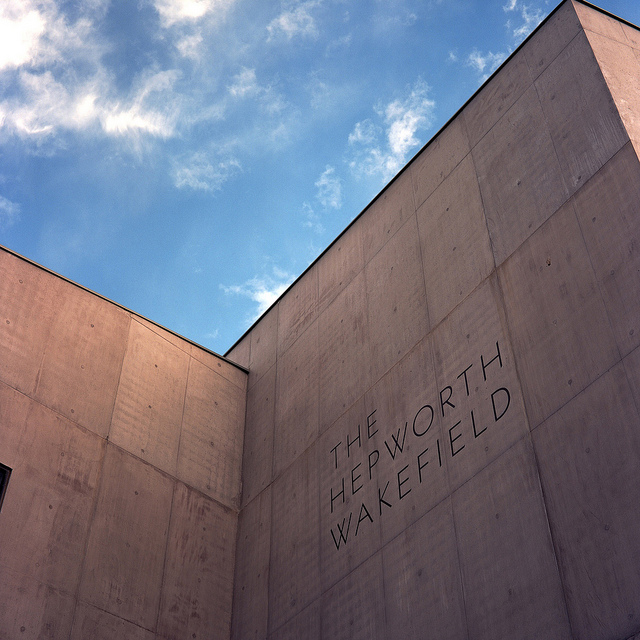
The Hepworth gallery caught the light well, bringing some warmth from the usually grey building. Leading lines bring the eye into the logo, and the blue and orange colours work well together.
The Harewood 50th Anniversary hillclimb
I took my camera along to the Harewood 50th anniversary hillclimb, with both black and white and color film in tow. The paddock would offer a good opportunity to photograph closeups of the cars sitting in the paddock.
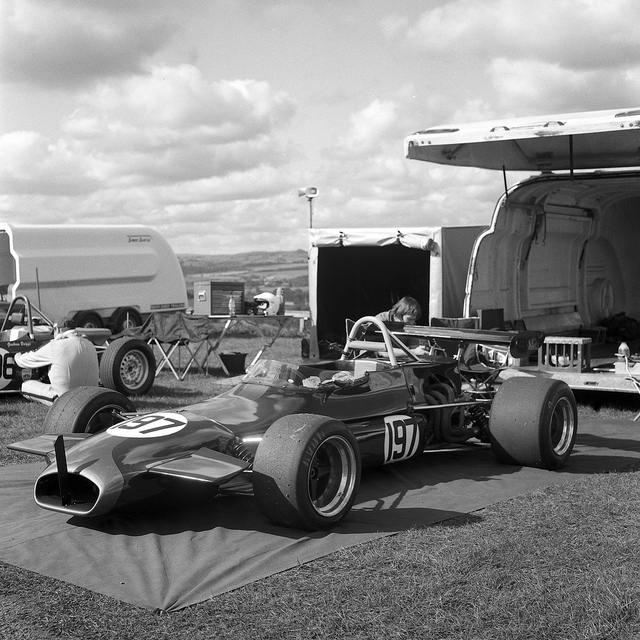
The Brabham at Harewood created a timeless looking image, with the details of the car coming through against the sky.
Colour Kodak Ektar 100 film once again proved to be excellent in the bright conditions at Harewood. Blue skies with a hint of cloud and lush green landscapes provided great background of the vintage Frazer Nash of James Baxter.
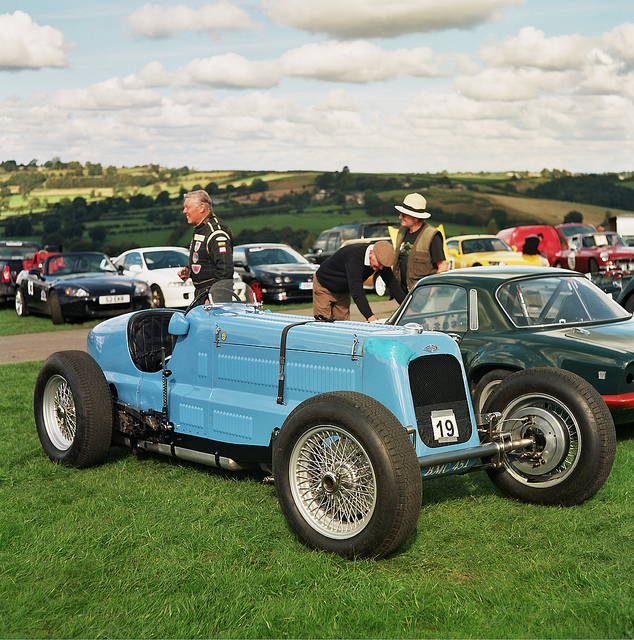
Beautiful vivid colours from Kodak Ektar 100 film brought out the best in James Baxter’s Frazer Nash.
An unlikely backup at Donington Park
After my 5D broke yet again during the FIA GT1/British GT/Formula 3 event at Donington Park, I was left with only my C330F to shoot on. I had to get creative with shots around the paddock and by the circuit.
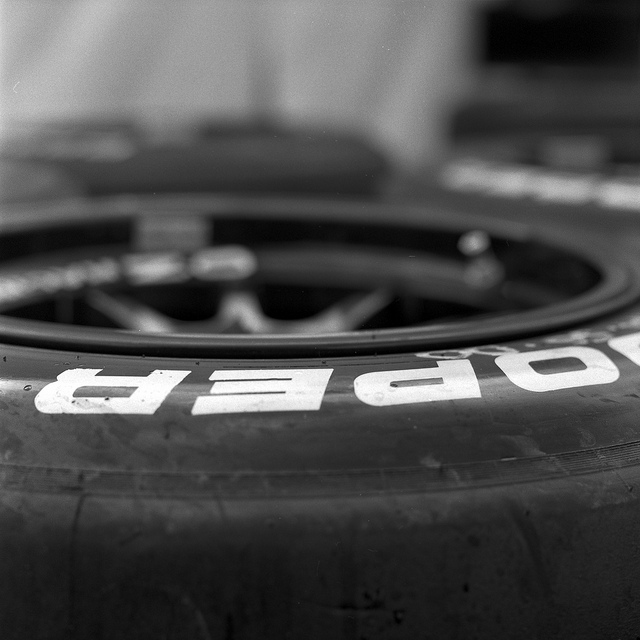
The paddock offered up some interesting subjects that I used the Mamiya’s excellent close up abilities to photograph
I think that the C330F’s ability to photograph close up is one of it’s most useful features. With very short minimum focusing distances, the camera can be much more useful as it can do a much larger variety of shots. The viewfinder does have an exposure compensation guage too, which not only shows the level of compensation needed, but also the parallax correction. This appears at the left of the ground glass when winding the focusing dial.
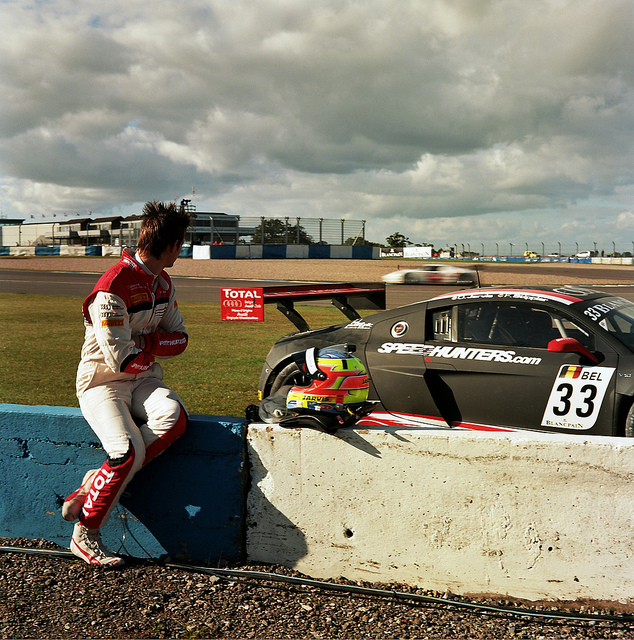
The driver sitting on the wall watches on as a car races by in the background. I really liked the colours and image quality that the C330F provided for this.
The camera took up the challenge well at this event, and I felt that the combination of being forced to be creative, and the versatility of the C330F allowed me to get some satisfying results.
Is this camera right for me?
If you’re wanting a high quality, yet affordable 6×6 medium format camera, then this is most definitely for you. You may have to carry a large weight around, along with a light meter, but the C330F will deliver when you do manage to set up and take your photograph.
If you’re looking for a camera that’s quick to point and shoot and generates loads of light leaks and distortions, then this camera is not for you, for the opposite reasons. Slow to set up, 12 shots per roll, and the need for a light meter make it a camera to savour, rather than one to blast away and hope for the best with.
I want one! Where can I get one?
Ebay is probably the best place to get the Mamiya C330F, or it’s earlier and later versions. Expect to pay between £150 – £350. I’d recommend the 80mm lens, as this is a very fast, high quality, versatile lens. There are additional lenses, as the Mamiya does allow for these to be changed (and is one of only a handful of TLRs to do so). I’d put my neck out and say that this camera is much better value for money than a Rolleiflex, even if there is no built in light meter.
What should I be careful of?
Obviously, as this camera has a bellows configoration, damage to this can be an issue. They are repairable, as are the lenses. The lens in my camera was very sticky when I bought it, but I sent it to be serviced at Sandean Cameras in London and it came back as good as new (although this did cost almost as much as the camera). They are worth repairing and keeping in circulation, as they do last well and produce excellent results.
Summing up and further reading
This is easily one of the best film cameras I own. It extracts the best out of any film stock, is very robust and well made, and the lens is simply incredible.
If you want to go waist level, this camera must be at the top of your list. 9/10
To see more photograph from the camera, check out my Mamiya C330F set on Flickr.
Posted in: 6x6, Film Photography, Medium Format, Review
